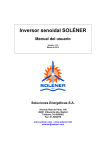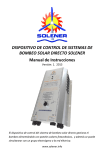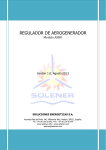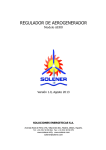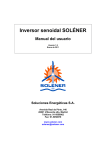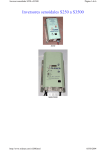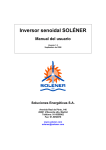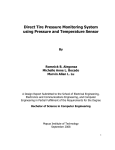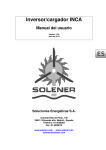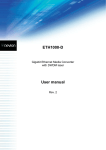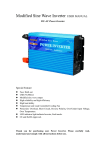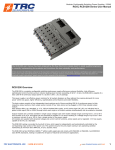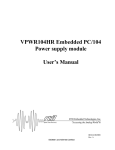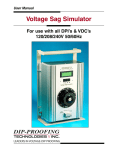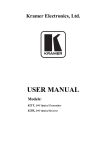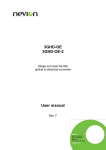Download Pure sinewave inverter - Soluciones Energéticas SA
Transcript
SOLENER Pure Sine Wave Inverter User Manual Version 1.13 August 2013 Soluciones Energéticas S.A. Avenida Real de Pinto, 146 28021 Villaverde alto, Madrid Tel: +34 91-5050062 Fax: +34 91-5050079 www.solener.com – www.solener.info [email protected] Inverter User Manual TABLE OF CONTENTS 1.- INVERTER DESCRIPTION 3 2.- FRONT PANEL INTERFACE 4 3.- INVERTER OPERATION 5 4.- INDICATORS AND SETTINGS 6 5.- INVERTER PROTECTIONS 5.1.- Overload Protection 7 5.2.- Over Temperature Protection 7 5.3.- Low and High Voltage Protection 7 6.- INSTALLATION INSTRUCTIONS 6.1.- Inverter Mounting 8 6.2.- Wiring 8 7.- START-UP PROCEDURE 9 8.- SHUT-OFF PROCEDURE 9 9.- PRECAUTIONS 9 10.- MAINTENANCE 9 11.- SAFETY INSTRUCTIONS 10 12.- TECHNICAL SPECIFICATIONS 11 13.- SERVICE CODES 11 14.- WARRANTY 12 Version 1.13, August 2013 2 Inverter User Manual 1.- INVERTER DESCRIPTION The SOLENER inverter is a pure sine wave inverter (DC to AC converter), designed for stand-alone photovoltaic applications and controlled by a microprocessor. It has been designed to provide an alternating sinusoidal output voltage of 230 volts, 50 hertz (there are also versions of 120 volts and/or 60 hertz) from an input voltage of 12, 24, 36 or 48 volts provided from electrochemical accumulators. It employs state of the art components, such as MOSFETs, 32-bit microcontrollers or LCD modules. In addition to its basic inverter function, it allows monitoring of the photovoltaic installation energy consumption, displaying information regarding energy, current intensity and other operating parameters. It is manufactured with full-bridge configuration and uses PWM (Pulse-Width Modulation) control. The SOLENER inverter can supply energy to different loads such as resistive loads (p. e. heater), inductive loads (refrigerators), motors (vacuum cleaners), and rectified loads (computer). It can supply power surges (within its power range) to provide the short peak of energy required to start some appliances or machines such as TV’s, projectors, videos, computers, refrigerators, washing machines, submersible pumps, sewage, heating boilers etc, without any difficulty. The inverter protects itself against short circuit, overload, over-temperature, voltage surge (overvoltage) and reverse polarity. Protection against reverse polarity does not occur through the destruction of the input fuse (as it occurs in other commercial inverters), it simply does not work. Start-up and shutdown is possible through any PROFESSIONAL SOLENER® CONTROLLER (using an optional control line). In addition, since the beginning of 2010 almost all versions feature a relay for generator start, which is activated (closing a potential-free contact) when the battery needs recharging. This relay can be configured to perform other functions; see some of these possible functions in section 13 or consult your need with us. This inverter reconnects automatically when the circumstances which caused the shutdown have disappeared (e.g. battery over voltage or under voltage, overheating or a control signal sent from the controller). If it detects overload or short-circuit following the elimination of the problem you will have to make a manual power cycle (upon request, reset can be automatic). Load detection is a special state (standby mode) whereby the inverter reduces its power consumption to a minimum whilst waiting for a load equal to or greater than the specified for its ignition. When it detects this load, the inverter starts and goes into normal mode of operation. If power consumption falls below the set limit, the inverter goes back into the detection mode. It is possible to adjust the load detection level from 0 Watts (continuous operation) up to about 100 Watts. If the power of the connected load is lower than the specified threshold power, the inverter will start and stop once per second until the load surpasses this set point. This will produce a characteristic blinking (especially notable in light bulbs). Versions prior to 4.00 have a potentiometer placed on the front panel to adjust the load detection threshold, whilst in all other versions this is adjusted through the menu, by pressing “Enter” and selecting the “Load threshold” option; when doing so, a Version 1.13, August 2013 3 Inverter User Manual bar whose length is proportional to the power required to exit the search mode appears on the display. If the bar’s length is zero the search mode is deactivated. 2.- FRONT PANEL INTERFACE The figures shown below are a front view of the three types of SOLENER® inverters, showing all the elements of the user interface. These element references will be used throughout this manual. The small model has one multi-color LED that brings together the functions of the seven LEDs present in rest of the models. 1. 2. 3. 4. 5. 6. 7. Alphanumeric Screen Acoustic Alarm Load Disconnection Indicator Shortcircuit Indicator Battery Over Voltage Indicator Battery Under Voltage Indicator Over Temperature Indicator Version 1.13, August 2013 8. Load Detection Indicator 9. Power ON Indicator 10. Load Detection Potentiometer (For versions prior to 4.00, see section 1) 11. ON / OFF switch 12. Setup Push Buttons 13. Relay Status Indicator 4 Inverter User Manual 3.- INVERTER OPERATION After switching ON the inverter, the unit carries out system checking sequences; if an error is detected the failure cause will be shown on the LCD display and the Load Disconnection LED Indicator will start to flash along with other LED indicators (depending on the failure). This type of failure does not allow the inverter to function properly therefore it will cut power supply to the load. As part of this self-test process the internal inverter fan will run for 1 second. After the self-test process, the AC output voltage will gradually increase from zero to its nominal value (soft start). If the load detection circuit is active and does not find loads greater than those predetermined, then the inverter will go into load detection (stand-by) mode reducing its power consumption and checking again once per second. When the battery voltage is lower than the “low battery voltage” setting, the acoustic alarm is activated and the “low battery” LED alarm begins flashing once per second. After 10 seconds this LED alarm will remain lit and the “Load Disconnection” LED will turn ON too, indicating that the inverter has been shut-off. If the battery voltage rises reaching a voltage above the predetermined restart voltage, the inverter will automatically start and both LEDs will turn OFF. If the battery voltage reaches 4/3 of the inverter rated battery input voltage (e.g: 16 volts in a 12 volt inverter) the “Battery Over Voltage” LED turns ON in conjunction with the “Load Disconnection” LED causing the AC output to shut-down. When the inverter DC voltage input drops to a value lower than the re-start voltage setting, the inverter will re-start automatically. Inverters produce heat when operating. The amount of heat produced is (almost) proportional to the amount of power supplied by the inverter. When the MOSFET reaches a certain programmed temperature (50 ºC by default), the internal fan is activated, stopping when the temperature drops below the preset temperature limit (normally 40 ºC). However, if the temperature keeps on rising (because the connected load is too high) and reaches 60 ºC, the output voltage will decrease by 10% in order to reduce the power; if despite this, the temperature keeps rising, the unit will shut off when the temperature reaches 80 ºC, restarting again at 60 ºC. System shut-down due to over temperature will be indicated by the corresponding yellow LED alarm simultaneously with the red “load disconnection” LED (the screen also indicates the cause of the load disconnection). Whilst the system is disconnected due to over temperature the fan will continue functioning. In models with input control, if this is not activated, the inverter will shut-down and the “Load Disconnection” LED indicator will turn on. When it is activated, the inverter restarts shutting off the correspondent LED alarm. Input control activation is made by closing a circuit. If a short-circuit is produced at the inverter output, the unit automatically limits the output power to protect the installation, and the short-circuit LED lights up. If the short-circuit lasts more than 10 seconds then the “Load Disconnection” LED will light up and the inverter will stop. Once the cause of the short-circuit has been eliminated it is necessary to reset the unit (using the ON/OFF switch) in order to recover the AC output. Version 1.13, August 2013 5 Inverter User Manual When an AC overload is detected, the inverter limits the time that power is supplied to the load (the time that this power will be supplied decreases as the overload increases). Once this time has passed, the inverter output shuts off and the “Load Disconnection” LED lights up. In order to recover full operation of the unit it will be necessary to reset the unit again (using the ON / OFF switch). 4.- INDICATORS AND SETTINGS The inverter is equipped with an alphanumeric LCD screen with 2 lines and 16 columns that displays information regarding the status of the inverter and the installation. On the front panel there are also 8 LEDs which indicate (from bottom to top): • • • • • • • • Relay (Green): indicates that the relay is active (See section 1). Power ON (Green): It indicates that the unit is functioning properly. Load Detection (Green): it flashes when the inverter is in “Load Detection” mode, and remains lit when it detects load. It turns off when the AC output is cut-off for any given reason. Over Temperature (Yellow): It turns on when the internal temperature is too high. Low Battery Voltage (Yellow): It flashes when the battery voltage is low (acts as a pre-disconnection alarm) and it remains lit (steady) when the inverter stops due to low battery voltage. High Battery Voltage (Yellow): It turns on when the battery voltage reaches 4/3 of the inverter rated battery input voltage and turns off when it drops to a safe operating voltage value. Overload (Red): It flashes when a short-circuit takes place. It remains lit if it exceeds the overload preset time. Load Disconnection (Red): It turns ON when the inverter has shut-off (AC output disconnected) to protect the installation or the inverter itself. The yellow or red LED that remains lit together with the “Load Disconnection” LED indicates the cause of the disconnection. If only the “Load Disconnection” LED is lit, then the disconnection was caused by a signal coming from the external control line or by a continuous overload. Information regarding the cause of the disconnection can be found on the screen. Simultaneously and as an additional aid, when the Battery Under Voltage” LED alarm or the “Short-circuit” LED alarms are flashing, an acoustic alarm (50 millisecond beep per second) will sound. Information about the unit is displayed in sequence on screen, (e.g.: input / output voltage and current, output power, peak power, energy consumption, internal temperature, working time...), as well as the cause of disconnection, if applicable. The load detection circuit is factory set to detect a load of (approximately) 1% of the nominal power. If you intend to connect a load whose power consumption is lower than this threshold, it may be necessary to add an additional load to ensure that the inverter comes out of standby mode (Load Detection Mode). The keypad allows the adjustment of some parameters, as well as resetting meter (counter) values to zero and maximum/minimum levels of the variables. It also allows Version 1.13, August 2013 6 Inverter User Manual you to scroll manually from screen to screen or to maintain activated an individual screen (always visible), when required. Pressing twice the central key will activate the screen that provides input voltage and current readings, leaving it fixed. 5.- INVERTER PROTECTIONS The inverter is protected against reverse polarity, overload, short-circuit, over temperature and battery voltages out of a reasonable range. Please see below a detailed description of each of the protections. Contact our technical service ([email protected]) for factory setting of automatic restart after overload or short-circuit. 5.1.- Overload Protection See table in section 12 for overload limits. The inverter gets latched in this condition. To reset, the power ON / OFF switch is required to be switched OFF and ON again (manual start-up). Before switching ON the inverter again, ensure that the cause of the overload is removed. 5.2.- Over-Temperature Protection As the inverter does not have, logically, 100% performance efficiency, it dissipates the difference in form of heat, particularly when the unit is operating close to its nominal power capacity. When the inverter is subject to a heavy load for a prolonged period of time, the overheating protection will be triggered in three stages: first activating its internal fan, then if the temperature keeps increasing it reduces the output voltage by 10% and if temperature continues rising it cuts output voltage altogether. When the temperature drops down to a certain value, the unit starts automatically. 5.3.- High and Low Battery Voltage Protection The inverter can operate within the range of battery voltages between 5/6 and 4/3 of its nominal voltage. This range is adjusted in factory depending on the type of battery that will be used. The battery model type can be selected using the Installer password. Shutdown due to low DC input voltage prevents the battery from fully discharging, otherwise it can cause irreversible damage to the battery. A delay time has been foreseen in the control circuit allowing the battery voltage to drop momentarily below these limits; this makes it possible to start induction motors or cold filament lamps with this inverter. The “Low Battery Voltage” LED alarm will flash while Version 1.13, August 2013 7 Inverter User Manual the preset voltage threshold is not reached, and remains lit after 10 seconds, shutting off the output. Shut-down due to high DC input voltage is intended to protect the inverter against irreversible damages. In both cases, when the battery voltage returns to a value within the acceptable working range, the unit will automatically restart. (After a shut-down due to low DC input voltage, the voltage has to raise significantly in order to allow the battery to recover). 6.- INSTALLATION 6.1.- Inverter Mounting The inverter must be fixed on a vertical surface, with its connection wires at the bottom of the unit and with at least 5 cm clearance at the top and at the bottom for adequate airflow. It should be placed high enough so that it is out of the reach of children and animals. The inverter should be fitted using screws placed through the four holes provided for such purpose. The lock-shaped holes allows you to place the screws in the wall before you put the inverter, and tightening them later. 6.2.- Wiring The inverter has three or four cable holders located in the bottom part, from which the following cables come out: • • • • A red cable (or with a red terminal) to connect to the positive (+) terminal of the battery. A black (or blue) cable to connect to the negative (-) terminal of the battery. A three wire cable (phase, neutral and ground) or an industrial connector for connection to the AC loads. An optional two wire cable to connect to the remote control. Battery cables have a terminal at the end which must be attached with bolts to the terminals of the battery. DO NOT EXTEND THESE CABLES. Be sure to properly fasten these bolts and retighten them after a few days. You must also make sure that all bolts used with battery connecting cables (jumper wire) are tight. If during the operation of the inverter any battery connecting cable is hotter than others, you should tighten its bolts and/or clean both battery terminals and connecting battery cables ends. Before connecting the unit ensure that the ON/OFF switch on the front panel is in the OFF position and that the house RCD (residual-current device, also known as GFI (ground fault interrupter) in U. S. and Canada) is open, then proceed as follows: • Connect the AC wires to the external output breaker. Live cable is brown, gray or black, the neutral cable is blue and ground cable is yellow and green. Neutral and ground cables are connected to the casing of the unit. Unit casing should be connected to an earthing rod that complies with the specifications described in the Version 1.13, August 2013 8 Inverter User Manual • • • Low Voltage Electro-technical Regulation. The ground cable must be in the low voltage circuit breaker distribution board. Connect the negative battery cable to the negative (-) terminal of the battery. Blow around the positive terminal of the battery to remove any accumulated hydrogen. Connect the positive battery cable to the positive (+) terminal of the battery. A small spark may appear when contact is made, this is normal. NOTES: - AC output voltage is very dangerous. You must always install an RCD at the inverter output for people and animal protection. - Switch the inverter off before manipulating the installation; it can start automatically without prior warning. 7.- START-UP PROCEDURE • • • • • Check all the connections to make sure that they are all correct. Turn the inverter on using the ON / OFF switch located on the front panel. Close the AC output breaker that you connected to the inverter output. If the load connected to the inverter is higher than that adjusted with the “load detection” potentiometer, the inverter will start and the output voltage will increase rapidly until it reaches its nominal value. If not, load will turn ON and OFF once per second. Verify that the RCD is working properly by pressing the test button on the front, if it trips then it is working properly. This cross-check must be done occasionally, as indicated by the manufacturer of the RCD. 8.- SHUT-OFF PROCEDURE When you are not going to use the inverter for a while, turn it off in order to save energy by using the ON / OFF switch located in the front panel. 9.- PRECAUTIONS • • • • • Do not manipulate the interior of the unit, there are no user serviceable parts inside. Do not connect any power supply to the inverter AC output, this includes generators and other inverters. Do not cover the ventilation slots or insert objects (especially metal ones). Protect the unit against exposure to direct sunlight and water. Do not install the inverter on top of the batteries, gases can damage it. Batteries generate hydrogen and oxygen during charging, resulting in an explosive gas mixture. Care should be taken to ventilate the battery area; follow the battery manufacturer’s recommendations. 10.- MAINTENANCE Version 1.13, August 2013 9 Inverter User Manual The inverter does not require any special maintenance. Periodic cleaning of the casing with a dry cloth is recommended. If necessary, a dampened cloth with soapy water can be used (never dampen with alcohol or solvents). 11. – SAFETY The inverter is reasonably protected against most of the possible causes of damage. The following table shows the possible causes of disconnection and their solutions. FAILURE RESULT SOLUTION Over-temperature “Load Disconnection” and “Overtemperature” LED alarms will turn on. Inverter does nothing. “Load Disconnection” and Shortcircuit” (if applicable) LED alarms will turn on. Inverter automatically restarts when temperature reaches the normal values. Reverse Polarity Overload or short-circuit High Battery voltage “Load Disconnection” and “High Battery Voltage”LED alarms turn on. Low Battery voltage “Load Disconnection” and “Low Battery Voltage”LED alarms turn on. Connect the battery correctly. Turn OFF the inverter, eliminate the cause of shortcircuit or overload. Reset the inverter by using the ON/OFF switch. Inverter automatically restarts when battery voltage drops to reconnection voltage. Inverter automatically restarts when battery voltage rises to reconnection voltage. If you restart the inverter after a low battery voltage disconnection then the it will work for a while before shutting down again. This is normal, because the battery is still depleted. You must wait for the battery to recharge partially, and the best way to achieve this is using the automatic restart feature of the inverter. Version 1.13, August 2013 10 Inverter User Manual 12.- TECHNICAL SPECIFICATIONS Output wave form.......................................................................................................... Pure Sine Wave Rated output voltage ............................................................................................ 230 (120 optional) VAC Rated output frequency ............................................................................................. 50 (60 optional) Hz Output frequency variations ......................................................................................................... < 0,1 % Output power variations ................................................................................................................... < 5 % Minimum Input Voltage ................................................................................................................ 5/6 Vnom Maximum Input Voltage ............................................................................................................... 4/3 Vnom Efficiency ......................................................................................................................................85-97 % Efficiency with nominal load .......................................................................................................... > 85 % Consumption (in detection)......................................................................................................... < 70 mA Harmonic Distortion ......................................................................................................................... < 5 % Environmental Protection Level ........................................................................................................ IP20 Relay Maximum Current ....................................................................................................... 1 A resistive Rated Power(VA) 500 750 1000 1250 1500 2200 2500 3000 4200 6000 Rated Voltage (V) 12/24 12 24 12 24 12 24/36/48 12 24/36/48 24/36/48 48 Overload 3 ’’ (VA) 750 1100 1500 1800 2200 3300 3700 4500 6300 9000 15000 Overload 50 ’’ (VA) 650 1000 1300 1600 1900 2800 3200 3900 5400 7800 13000 Overload 6 ’ (VA) 600 900 1200 1500 1800 2600 3000 3600 5000 7200 12000 Length (mm) 115 315 315 315 460 460 460 535 535 535 647 Height (mm) 230 118 118 118 157 157 157 178 178 178 210 Width (mm) 154 192 192 192 255 255 255 285 285 285 344 Net Weight (kg) Relay (see Section 1) 10000 4 9 9 12 20 22 22 24 36 36 68 NO NO NO NO NO YES YES YES YES YES YES PROTECTIONS • Against Reverse Polarity (using intelligent diode) • Against High and Low Voltage • Against Shortcircuit and Overload • Against Over Temperature 36 V input or 120 V / 60 Hz output available upon request. Aluminum casing protected with epoxy paint. DATA SUBJECT TO CHANGE WITHOUT NOTICE. 13.- SERVICE CODES These codes are an excerpt of those that can be used in the Service option in the menu to change the relay mode of operation: 65435470 ................................. Relay contacts close to start generator (default value) 65435471 ......................................................... Relay contacts open to start generator 6243547E ..............................................Relay contacts close when power is too high 66435476 ................................ Relay contacts close when there is low battery voltage 61435478 .......................................... Relay contacts close when AC output is shut-off 6043547A ..................................Relay contacts close when there is over temperature Version 1.13, August 2013 11 Inverter User Manual 14.- WARRANTY SOLUCIONES ENERGÉTICAS, S.A. guarantees that its products comply with all written specifications in this manual. The warranty period of SOLENER products are 2 years, which will begin to take effect from product shipment date from SOLUCIONES ENERGÉTICAS S.A. or, if it is sold to an authorized retailer, from the authorized retailer shipment date to the customer. SOLUCIONES ENERGÉTICAS, S.A. may, at its discretion and cost, repair or replace products for new or reconditioned ones, provided they are returned by the buyer together with date and proof of purchase. If, SOLUCIONES ENERGÉTICAS S.A., after examining and testing any product returned by the buyer for repairing or replacement, finds, that such product is not faulty, he will inform the customer and will dispose of the product according to customers instructions with costs bared by the customer, and the customer shall pay to SOLUCIONES ENERGÉTICAS S.A. the costs incurred to examine and test the product according to prevailing rates. The warranty is solely limited to the repair (materials and labor) of the equipment, in no case includes travel expenses, freight or shipping costs, or any damage caused by the use of or inability to use the equipment. The use of our products in life support devices without the express written permission of our company President is specifically prohibited. The use or continued possession of the products after the expiration of the warranty period, shall be deemed as conclusive evidence that the warranty has been fulfilled to the full satisfaction of the buyer. The warranty set forth above shall not apply to the faults or defects caused by misuse, abnormal use or product abuse, or by negligence, alteration, improper installation, opening, unauthorized modification, inadequate testing, entry of foreign bodies, animals or gases, accidents or external causes to the product, including those of force majeure such as earthquakes, hurricanes or floods. In case of non acceptance of the warranty terms and conditions, equipment must be returned in a term not exceeding 15 days with all original accessories and in its original packaging. Version 1.13, August 2013 12












